Reported Road Casualties Scotland 2013
Article 2: In Focus: Pedal and Motor Cycle Casualties
In Focus: Pedal and Motor Cycle Casualties
Key Points
- Two wheeled road users are overrepresented in the reported road casualty statistics. Both pedal and motor cycles account for less than 1 per cent of road traffic[2] each, yet they account for 8 and 7 per cent of casualties respectively.
- As with all road accidents, pedal cycle and motor cycle casualties are more likely to be killed or seriously injured on faster roads in rural areas.
- For pedal cycle casualties, most injuries occur on roads in built up areas.
- Motor cycle casualties were evenly distributed between built-up and non built-up roads, however, more fatalities occurred on non built-up roads, where the speed limits were higher.
- Over eighty per cent (82%) of pedal cycle casualties and nearly ninety per cent (88%) of motor cycle casualties were male.
- Cars are over represented in accidents involving motor cycles and pedal cycles.
- In 2013, three quarters of pedal cycle casualties were involved in accidents within 5 km of home; 45 per cent of motor cycle casualties occurred within 5 km of home. 12% of motor cyclists injured were so more than 50 km from home; compared with only 2% of pedal cyclists.
Background
1.1 Casualty numbers have been falling over recent years but the numbers for some groups of road users have shown differing trends. This article looks in more detail at the casualty numbers of pedal cycle and motor cycle road users to identify patterns in the data to assist with targeting interventions for these groups of road users that may be considered as some of those most vulnerable.
1.2 When looking at subsets of casualties to look for trends and patterns, using a single year of data can lead to erroneous conclusions. In general, this analysis looks at 5 years of data for the whole of Scotland to identify key patterns in casualty numbers over the period. The maps include eight years of data to ensure patterns can be identified across larger geographic areas.
1.3 All analysis in this article uses the same data as the analyses contained in the statistical commentary and tables, a snapshot taken 5 September 2014 from the Transport Scotland Reported Road Accidents database. These data are based on data supplied in the STATS19 collection form by Police Scotland.
Pedal Cycle Casualties
Pedal Cycle Casualties - Key Points
- Pedal Cycle casualties account for 8 per cent of all casualties, yet the Department for Transport estimates that cycle traffic accounts for less than 1 per cent of all traffic.
- Pedal cycle casualties fell by 3% between 2012 and 2013; but 2013 numbers are 10% higher than in 2009. The increase from 2009 has been driven by increases in slight injuries; fatalities have increase consistently since 2009 but are still relatively low (5 in 2009; 13 in 2012).
- Most pedal cycle casualties occurred on slower roads but more fatalities occurred on roads with higher speed limits. 35% of people injured on roads with speed limits of more than 40 mph were killed or seriously injured; compared to 17% on roads with speed limits up to 40 mph. Sixty three per cent of fatalities were on rural roads.
- Most accidents resulting in an injured pedal cyclist involve a car (83% involve cars and only 2% involve LGVs or HGVs)
- 82 per cent of pedal cycle casualties are male and 44 per cent of all pedal cycle casualties are aged between 30 and 49 (the peak age groups).
Pedal Cycle Casualties - An overview
2.1 The Department for Transport estimate that, in 2012 (the latest data available), pedal cycle traffic accounted for less than 1 per cent of all traffic1. However, in 2013 the number of pedal cycle casualties accounted for 8 per cent of all casualties, and pedal cycle fatalities also accounted for 8 per cent of all deaths of Scottish roads.
2.2 The number of pedal cycle casualties reported to the police since 2009 are shown in the table below, along with the latest five year averages used within this article.
| Year | Killed | Serious | Slight | All severities |
|---|---|---|---|---|
| 2004 to 2008 average | 9 | 134 | 613 | 756 |
| 2009 | 5 | 152 | 647 | 804 |
| 2010 | 7 | 138 | 636 | 781 |
| 2011 | 7 | 156 | 661 | 824 |
| 2012 | 9 | 168 | 729 | 906 |
| 2013 | 13 | 148 | 722 | 883 |
| 2009 to 2013 average | 8 | 152 | 679 | 840 |
| Percentage change between 2012 and 2013 | 44% | -12% | -1% | -3% |
| Percentage change since 2004 to 2008 average | 44% | 10% | 18% | 17% |
2.3 Pedal cycle casualties fell by 3 per cent between 2012 and 2013. Serious casualties fell by 12 per cent however fatalities increased by 44 per cent over the year (from 9 in 2012 to 13 to 2013). The figures below look at the changes in casualty numbers in the last 5 years and from the 2004-2008 averages. As shown there has been a 17 per cent increase in pedal cycle casualties since the 04-08 average, and a 10% increase since 2009. The increase since 2009 corresponds with DfT estimates of a similar percentage increase in cycle traffic on Scottish roads (up 8%) between 2009 and 20121 (the latest data available at time of publication).
Pedal cycle casualties by severity, 2009 to 2013
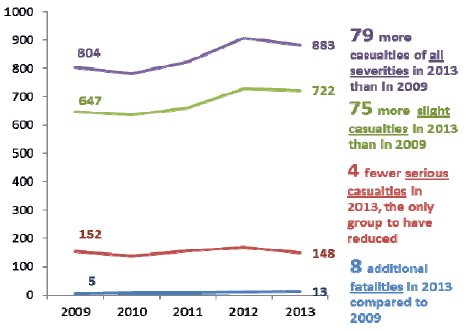
2004-2008 average based indices of pedal cycle casualties by severity
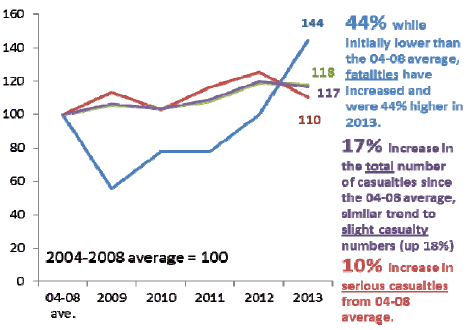
2.4 The distribution of injury road accidents involving pedal cycles is similar to that for all casualties as the image below shows. There are clusters of pedal cycle casualties in the built up areas of the central belt and casualties dotted along the routes through rural areas. As other findings show, this is unsurprising as most pedal cycle casualties will occur where pedal cycles and other road users are interacting.
Injury road accidents across Scotland, 2006-2013
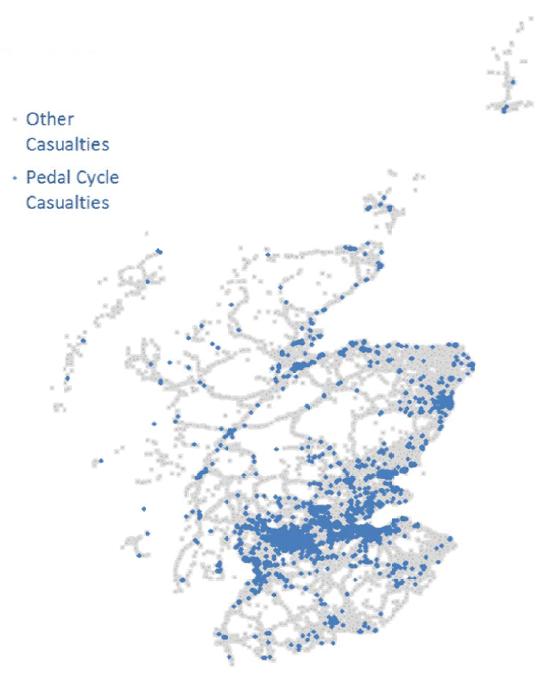
Pedal Cycle Casualties - Findings
2.5 The following analyses and findings supplement those covered in section 3.5 of the statistical commentary associated with this publication.
2.6 Speed limits
- The patterns seen here will be in part due to traffic speeds but will also reflect the amount of the network with each of these speed limits as well as the amount of traffic on these roads.
- Most fatalities happen on faster roads. Between 2009 to 2013 there was an annual average of 8 fatalities on our roads. On average, 5 of these per annum occurred on non built-up roads, where the speed limit is more than 40 mph.
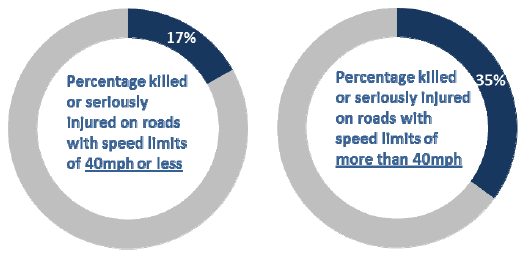
- But more injuries happen on roads with lower speed limits. Almost 90 per cent of pedal cycle casualties occurred on roads with a speed limit of 40 mph or less (88% of all casualties and 80% of serious injuries).
- More than one third (35%) of casualties on roads with speed limits of 40 mph or more were killed or seriously injured (5% were killed). On roads with a speed limit of 40 mph or less, 17% were killed or seriously injured (less than 1% were killed).
- Nearly two thirds (63%) of all pedal cycle fatalities happened on roads with speed limits of 60 mph. A quarter occurred on 30 mph roads, and 13% on 40 mph roads.
- More than four out of five pedal cycle casualties of all severities occurred on roads with speed limits of 30 mph. One in ten were on 60 mph roads. Lower proportions of casualties occurred across roads with other speed limits. As severity of injury increases so does the proportion of casualties occurring on roads with higher speed limits.
2.7 Urban Rural
- DfT traffic estimates suggest around half of cycle travel was on urban roads and half was on rural roads. If there was equal risk to pedal cyclists across Scotland, 50 per cent of casualties would be expected in urban areas and 50 per cent in rural areas.
- Eighty three per cent of pedal cycle casualties were on roads in urban areas. (76% of serious injuries and 85% of slight).
- Sixty three per cent of fatalities were on rural roads.
- Twenty nine per cent of casualties in rural areas are killed or seriously injured. In urban areas, the figure is around 17 per cent.
2.8 Other vehicles involved
- Cars are over represented in pedal cycle casualty numbers accounting for 83% of vehicles involved, yet cars account for only 78% of traffic.
- The majority of injury accidents reported to the police resulting in pedal cycle casualties involve cars. More than four out of five vehicles involved in accidents resulting in a pedal cycle casualty are cars. The majority of the goods vehicles involved are van under 3.5 tones (LGVs) (6% of all other vehicles involved).
Other vehicles involved in accidents resulting in pedal cycle casualties
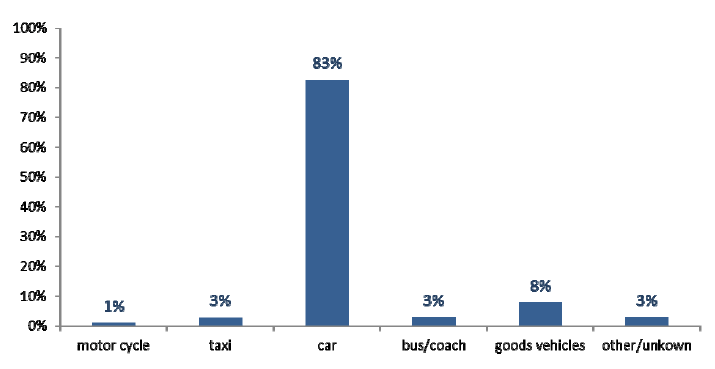
2.9 Age and gender
- Sixteen per cent of pedal cycle casualties were under 16. Only one of the eight pedal cyclists killed each year on average between 2009 and 2013 were under 16. Fourteen per cent of seriously injured pedal cyclists were under 16.
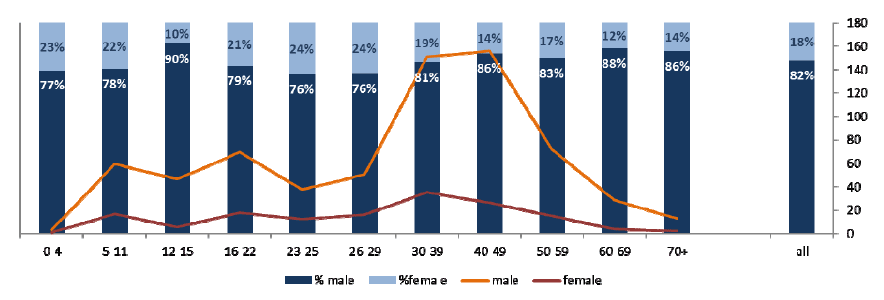
- As shown in the figure above, the majority of casualties across all age groups were male and 82 per cent of all pedal cycle casualties were male.
- The peak age groups for both male and female casualties were between 30 and 49, with an average of 151 male casualties aged 30-39, 156 aged 40-49 and an average of 35 and 26 female casualties in the respective age groups.
2.10 Estimated distance from home
- In 2013, three quarters of pedal cycle casualties were involved in accidents within 5 km of home (48% occurred within 2 km of home). Compared to just over half (54%) of all reported casualties occurring within 5 km of home (33% within 2 km).
- Only 2% occurred more than 50 km from home.
Motor cycle Casualties
Motor Cycle Casualties - Key Points
- Motor cyclists are overrepresented in the total number of casualties on Scotland's roads; and even more so in the number of fatalities. In 2013 motor cyclist casualties accounted for 7 per cent of all casualties and 13 per cent of all fatalities; compared to less than 1 per cent of all road traffic1.
- In general, motor cyclist casualties have been falling in recent years. Although fatalities increased by 10 per cent between 2012 and 2013, overall casualty numbers fell by 11 per cent; since 2009 the total number of casualties has fallen by almost a quarter (24%) and fatalities have almost halved (down 47%).
- Injury accidents involving motorcycles are spread equally between urban and rural areas.
- Most fatalities and serious injuries happen in rural areas with higher speed limits.
- Where another vehicle is involved, the majority (83%) are cars.
Motor Cycle Casualties - An Overview
3.1 The Department for Transport estimate that motor cycle traffic[3] accounted for less than 1 per cent of total traffic on Scottish roads in 2012 (the latest data available). In 2013, motor cyclists casualties accounted for 7 per cent of all casualties in road accidents reported to Police Scotland. Motor cyclist fatalities were over represented to a greater extent; accounting for 13 per cent of all deaths of Scottish roads in 2013.
3.2 The number of motor cycle casualties reported to the police between 2009 and 2013 are shown in the table below, along with the latest five year averages that will be used throughout this article.
| Year | Killed | Serious | Slight | All severities |
|---|---|---|---|---|
| 2004 to 2008 average | 42 | 371 | 637 | 1049 |
| 2009 | 43 | 332 | 646 | 1021 |
| 2010 | 35 | 319 | 491 | 845 |
| 2011 | 33 | 293 | 482 | 808 |
| 2012 | 21 | 342 | 504 | 867 |
| 2013 | 23 | 280 | 470 | 773 |
| 2009 to 2013 average | 31 | 313 | 519 | 863 |
| Percentage change between 2012 and 2013 | 10% | -18% | -7% | -11% |
| Percentage change since 2004 to 2008 average | -45% | -25% | -26% | -26% |
3.3 Motor cyclist casualties fell by 11 per cent between 2012 and 2013, however, fatalities increased by 10 per cent over the same period. Over the last year there has been an 18 per cent decrease in the number of serious casualties and a 7 per cent decrease in slight casualties. Since 2009 the number of fatalities have nearly halved (down 47 per cent) and total casualty numbers have fallen by a quarter (down 24 per cent). DfT estimate and decrease of 10% in motor cycle traffic between 2009 and 2012 (the latest data available)1.
Motor cycle casualties by severity, Scotland, 2009-2013
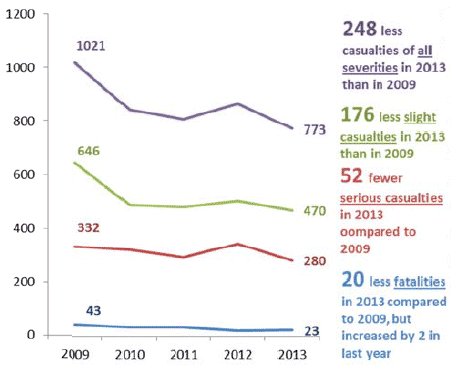
2009 based indices of motor cycle casualties by severity, Scotland
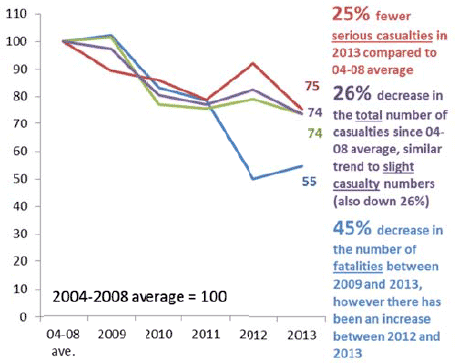
3.4 The majority of those injured on motor cycles were the rider; 6 per cent of those killed, those seriously injured and all casualties were as passengers on motor cycles.
3.5 The distribution of injury road accidents involving motor cycles is similar to that for all casualties as the image below shows. However, when compared to the distribution of pedal cycle casualties, covered in section 2.4, it can been seen that motor cycle casualties are less clustered in urban areas; with routes through rural Scotland showing more motor cycle casualties than was the case for pedal cyclists.
Injury road accidents across Scotland, 2006-2013
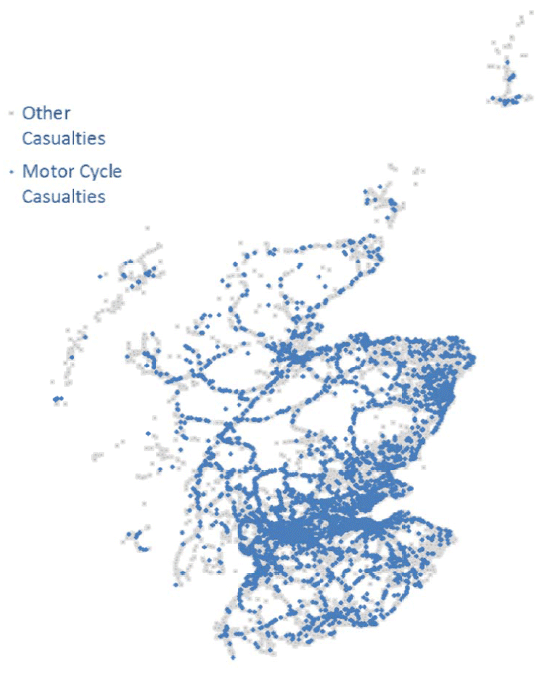
Motor Cycle Casualties - Findings
3.6 These findings supplement those already covered in section 3.6 of statistical commentary.
3.7 Speed limits
- The patterns seen here will be in part due to traffic speeds but will also reflect the amount of the network with each of these speed limits as well as the amount of traffic on these roads.
- Most fatalities happen on faster roads. 81 per cent of the annual average fatalities between 2009 to 2013 occurred on non built-up roads, where the speed limit is more than 40 mph.
- But injuries have been more evenly split between built-up and non built-up roads. 51 per cent of motor cycle casualties occurred on roads with a speed limit of 40 mph or less (39% of serious injuries occurred on these roads).
- One quarter of casualties on roads with speed limits of 40 mph or more were killed or seriously injured (6% were killed). On roads with a speed limit of 40 mph or less, 30% were killed or seriously injured (1% were killed).
- 81 per cent of all motor cycle fatalities happened on roads with speed limits of 60 mph or more. 13 per cent occurred on 30 mph roads, and 6 per cent on 40 mph roads.
- Nearly half (47%) of all motor cycle casualties occurred on roads with speed limits of 60 mph or more. Forty five per cent occurred on roads with speed limits of 30 mph or less.
3.8 Urban Rural
- DfT traffic estimates suggest almost two thirds of motorcycle travel is on rural roads.
- The majority of fatalities occur in rural areas. 87% of motorcycle fatalities occurred on roads in rural areas.
- Fifty three per cent of casualties are in rural areas. (44% of slight injuries and 63% of serious).
- Half of casualties in rural areas are killed or seriously injured. In towns and cities, the figure is 29 per cent.
3.9 Other vehicles involved
- Where another vehicle is involved, the majority (83%) are cars. 9% involved goods vehicles, including all vans, LGV and HGVs (6 per cent were LGV and 3 per cent HGV).
- Cars are over represented in motor cycle casualty numbers accounting for 83% of other vehicles involved, yet cars account for only 78% of mileage driven.
Other vehicles involved in accidents resulting in motor cycle casualties
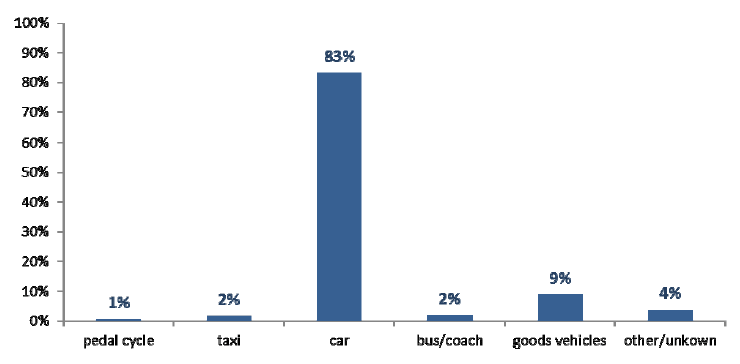
3.10 Age and gender
- One per cent of motor cycle casualties were under 16. This low number will be a result of the legal age to drive a motor cycle or moped.
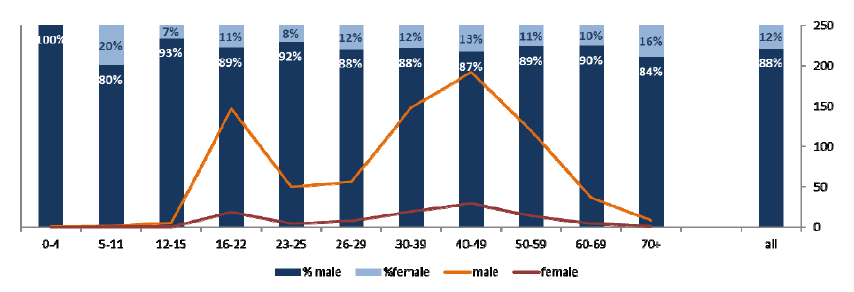
- The 40-49 age band accounted for just more than a quarter (26%) of motor cycle casualties and 28 per cent of those killed and seriously injured. There was another spike for those aged 16-22 who accounted for 19% of all casualties.
- The majority (88%) of motor cycle casualties in 2013 were male.
3.11 Estimated distance from home
- Motor cycle casualties are more evenly spread across the average distances from home, with a slightly larger amount occurring at shorter distances.
- Forty five per cent of motor cycle casualties are estimated to have occurred within 5km of home in 2013.
- Twelve per cent occurred more than 50 km from home.